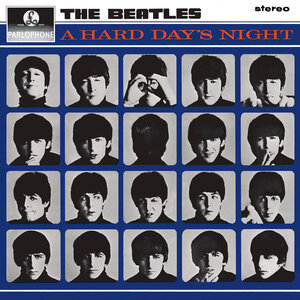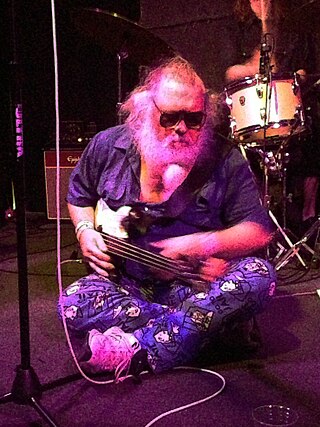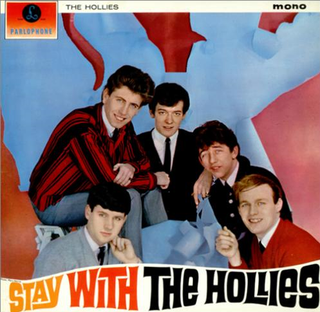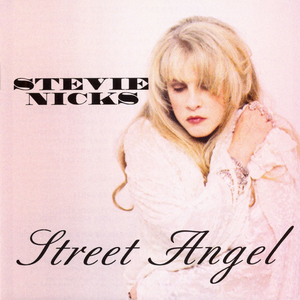
A Hard Day's Night is the third studio album by the English rock band the Beatles, released on 10 July 1964 by Parlophone, with side one containing songs from the soundtrack to their film of the same name. The American version of the album was released two weeks earlier, on 26 June 1964 by United Artists Records, with a different track listing that included selections from George Martin's film score. In contrast to the Beatles' first two albums, all 13 tracks on A Hard Day's Night were written by John Lennon and Paul McCartney, showcasing the development of their songwriting partnership.

Sir George Henry Martin was an English record producer, arranger, composer, conductor, and musician. He was commonly referred to as the "fifth Beatle" because of his extensive involvement in each of the Beatles' original albums. Martin's formal musical expertise and interest in novel recording practices facilitated the group's rudimentary musical education and desire for new musical sounds to record. Most of their orchestral and string arrangements were written by Martin, and he played piano or keyboards on a number of their records. Their collaborations resulted in popular, highly acclaimed records with innovative sounds, such as the 1967 album Sgt. Pepper's Lonely Hearts Club Band—the first rock album to win a Grammy Award for Album of the Year.

Philip Tyler Keaggy is an American acoustic and electric guitarist and vocalist who has released more than 55 albums and contributed to many more recordings in both the contemporary Christian music and mainstream markets. He is a seven-time recipient of the GMA Dove Award for Instrumental Album of the Year, and was twice nominated for a Grammy Award for Best Rock Gospel Album. He has frequently been listed as one of the world's top-two "finger-style" and "finger-picking" guitarists by Guitar Player Magazine readers' polls, and due to his complex and virtuosic playing, he is widely regarded as one of the greatest guitarists of all time.
The Beatles' bootleg recordings are recordings of performances by the Beatles that have attained some level of public circulation without being available as a legal release. The term most often refers to audio recordings, but also includes video performances. Starting with vinyl releases in the 1970s, through CD issues in the late 1980s, and continuing with digital downloads starting in the mid 1990s, the Beatles have been, and continue to be, among the most bootlegged artists.
Stars on 45 was a Dutch novelty pop act that was successful in Europe, the United States, and Australia in the early 1980s. The group later shortened its name to Stars On in the U.S., while in the United Kingdom and Ireland it was known as Starsound. The band, which consisted solely of studio session musicians under the direction of Jaap Eggermont, formerly of Golden Earring, recorded medley recordings made by recreating hit songs as faithfully as possible and joining them together with a common tempo and underlying drum track.

James Lee Keltner is an American drummer and percussionist known primarily for his session work. He was characterized by Bob Dylan biographer Howard Sounes as "the leading session drummer in America".

Wild Honey is the 13th studio album by the American rock band the Beach Boys, released on December 18, 1967, by Capitol Records. It was the group's first foray into soul music and was heavily influenced by the R&B of Motown and Stax Records. The album was the band's worst-selling at that point, charting at number 24 in the US. Lead single "Wild Honey" peaked at number 31, while its follow-up "Darlin'" reached number 19. In the UK, the album peaked at number seven.

Red Rose Speedway is the second studio album by the English-American rock band Wings, although credited to "Paul McCartney and Wings". It was released through Apple Records on 4 May 1973, preceded by its lead single, the ballad "My Love". By including McCartney's name in the artist credit, the single and album broke with the tradition of Wings' previous records. The change was made in the belief that the public's unfamiliarity with the band had been responsible for the weak commercial performance of the group's 1971 debut album Wild Life.

The Andantes were an American female session group for the Motown record label during the 1960s. Composed of Jackie Hicks, Marlene Barrow, and Louvain Demps, the group sang background vocals on numerous Motown recordings, including songs by Martha Reeves & the Vandellas, the Temptations, Stevie Wonder, the Four Tops, Jimmy Ruffin, Edwin Starr, the Supremes, the Marvelettes, Marvin Gaye and the Isley Brothers, among others. It is estimated they appeared on 20,000 recordings.

Glennon Ricketts Jr., professionally known as Glenn Lewis, is a Canadian neo soul singer–songwriter. Lewis earned a Grammy Award nomination in 2004 and has also won a Juno Award out of a total of six nominations.
"Across the Universe" is a song by the English rock band the Beatles. It was written by John Lennon and credited to Lennon–McCartney. The song first appeared on the 1969 various artists' charity compilation album No One's Gonna Change Our World and later, in a different form, on their 1970 album Let It Be, the group's final released studio album. The original version featured on two different albums both titled Rarities: a 1978 British release and a 1980 US release. It was also included on their 1988 album Past Masters, Volume Two. The song has been covered by many artists, including David Bowie on his 1975 album Young Americans, which featured contributions from Lennon.

Bob Loyce Moore was an American session musician, orchestra leader, and double bassist who was a member of the Nashville A-Team during the 1950s and 1960s. He performed on over 17,000 documented recording sessions, backing popular acts such as Elvis Presley and Roy Orbison. Bob was also the father of multi-instrumentalist R. Stevie Moore, who pioneered lo-fi/DIY music. The New York Times called him "an architect of the Nashville Sound of the 1950s and '60s" in his obituary.

Robert Steven Moore is an American multi-instrumentalist, singer, and songwriter who pioneered lo-fi music. Often called the "godfather of home recording", he is one of the most recognized artists of the cassette underground, and his influence is particularly felt in the bedroom and hypnagogic pop artists of the post-millennium. Since 1968, he has self-released approximately 400 albums, while about three dozen "official" albums have been issued on various labels.

Let The Sunshine In is the sixteenth studio album by Diana Ross & the Supremes recorded and released by Motown in 1969. It contains the hit single "I'm Livin' in Shame", "The Composer," a Smokey Robinson composition that peaked at number 27, and "No Matter What Sign You Are," - a single produced by Motown chief Berry Gordy that failed to crack to Top 30. Motown had titled the album “No Matter What Sign You Are” originally; going as far as creating the front cover art with the title in it, but when the single didn’t chart as expected the album was retitled “Let The Sunshine In.” Though the album was released when the group consisted of Diana Ross, Mary Wilson and Cindy Birdsong, original founding member Florence Ballard appears on two songs.

Elvis is the second studio album by American rock and roll singer Elvis Presley, released by RCA Victor on October 19, 1956 in mono. Recording sessions took place on September 1, September 2, and September 3 at Radio Recorders in Hollywood, with one track left over from the sessions for Presley's debut album at the RCA Victor recording studios on January 30 in New York. It spent four weeks at #1 on the Billboard Top Pop Albums chart that year, making Presley the first recording artist to have both albums go straight to number one in the same year. It would go on to spend 5 weeks at #1 in total. It was certified Gold on February 17, 1960, and Platinum on August 10, 2011, by the Recording Industry Association of America.

Stay with the Hollies, also known by its American release title Here I Go Again, is the debut album by the British rock band the Hollies and was released in January 1964 on Parlophone Records. In Canada, it was released on Capitol in July 1964, with a different track listing. In the US, Imperial Records issued the album under the title Here I Go Again in June 1964 to capitalize on the moderate success of the singles "Here I Go Again" and "Just One Look". It also features covers of well-known R&B songs, not unusual for Beat groups of the day.

Street Angel is the fifth studio album by American singer and songwriter Stevie Nicks. Released in 1994, the album peaked at No. 45 on the Billboard 200 albums chart and has been certified Gold by the RIAA for shipments of over 500,000 copies.

Teenage Spectacular is a 12" vinyl record album by DIY home recording pioneer and one-man band R. Stevie Moore, released in 1987. It was the third of four RSM albums released by New Rose Records in Paris, France. Like 1986's Glad Music, Teenage Spectacular differed from most Moore record albums by being almost exclusively recorded in a professional 8 & 16 track studio. Never officially reissued on compact disc, the expanded CD-R version is available by mail from the artist.
"Why Should I Love You?" is a song written by American singer-songwriter R. Stevie Moore, released as the ninth track of his album Glad Music (1986). It was announced in May 2012 that the track would also appear on Lo Fi Hi Fives ...A Kind Of Best Of, a hits collection from Moore; scheduled for a release on August 5, 2012.

Hotgun is an album purported to be the self-titled debut record of a band called Hotgun, released by tax-scam label Guinness Records. The album is actually a composite, combining demo recordings made by members of a Nashville area band called Ethos, with cover versions of popular songs recorded by employees of Nashville recording studio, Audio Media, originally intended for compilation albums.
















